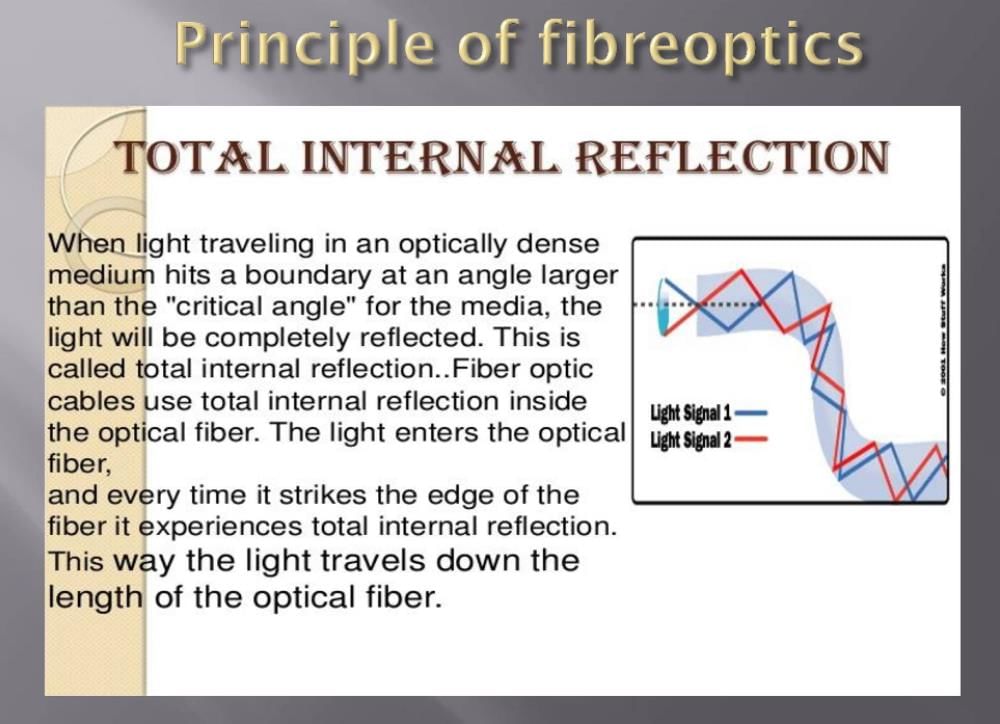All Exams >
MCAT >
MCAT Chemical and Physical Foundations >
All Questions
All questions of Geometrical Optics (PHY) for MCAT Exam
Two plane mirrors of length L are separated by distance L and a man M2 is standing at distance L from the connecting line of mirrors as shown in figure. A man M1 is walking in a straight line at distance 2L parallel to mirrors at speed u, then man M2 at O will be able to see image of M1 for total time : 
- a)

- b)

- c)

- d)

Correct answer is option 'C'. Can you explain this answer?
Two plane mirrors of length L are separated by distance L and a man M2 is standing at distance L from the connecting line of mirrors as shown in figure. A man M1 is walking in a straight line at distance 2L parallel to mirrors at speed u, then man M2 at O will be able to see image of M1 for total time :
a)
b)
c)
d)

|
Praveen Kumar answered |
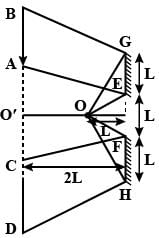
The light from man M1 hits the mirror and then reaches the man M2. The positions of the moving man need to be found when the light from him hits the corners of the mirror to reach the standing man.
From geometry,
AO′=L/2+2(L/2)
=3L/2
Similarly, BO′=(3L/2)+2(3L/2)
=9L/2
Hence AB=(9L/2)-(3L/2)=3/2
Time taken to cover this distance=3L/u
Similarly time taken to cover CD=3L/u
Thus total time he is visible is 6L/u
Figure shows a plane mirror onto which a light ray is incident. If the incident light ray is turned by 10° and the mirror by 20°, as shown, find the angle turned by the reflected ray. 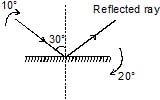
Correct answer is '30'. Can you explain this answer?
Figure shows a plane mirror onto which a light ray is incident. If the incident light ray is turned by 10° and the mirror by 20°, as shown, find the angle turned by the reflected ray.
|
|
Krishna Iyer answered |
The reflected ray will turn 100 due to incident ray and 400 due to mirror in opposite direction
∴ Net rotation =40−10
=300
Hence,
300 is the correct answer.
∴ Net rotation =40−10
=300
Hence,
300 is the correct answer.
There are two plane mirror inclined at 40°, as shown. A ray of light is incident on mirror M1. What should be the value of angle of incidence 'i' so that the light ray retraces its path after striking the mirror M2. 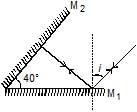
Correct answer is '40'. Can you explain this answer?
There are two plane mirror inclined at 40°, as shown. A ray of light is incident on mirror M1. What should be the value of angle of incidence 'i' so that the light ray retraces its path after striking the mirror M2.

|
Ciel Knowledge answered |
The ray strikes M2 normally
so r=90o-40o=50o
to the horizontal
=40 to the normal
As i=r
i=40o
so r=90o-40o=50o
to the horizontal
=40 to the normal
As i=r
i=40o
A virtual image, larger than the object can be produced by- a)Convex mirror
- b)Concave mirror
- c)Plane mirror
- d)Concave lens
Correct answer is option 'B'. Can you explain this answer?
A virtual image, larger than the object can be produced by
a)
Convex mirror
b)
Concave mirror
c)
Plane mirror
d)
Concave lens
|
|
Ayaan Madhukar answered |
CONCAVE MIRROR...
Concave mirrors produce real and virtual, erect and inverted, diminished same size and magnified image depending upon the position of the object on the principal axis.
But the concave mirror forms a virtual and enlarged image when the object is placed between the focus and the pole of the mirror...
$$Hope it's help...$$
Concave mirrors produce real and virtual, erect and inverted, diminished same size and magnified image depending upon the position of the object on the principal axis.
But the concave mirror forms a virtual and enlarged image when the object is placed between the focus and the pole of the mirror...
$$Hope it's help...$$
The radius of curvature of the left & right surface of the concave lens are 10 cm & 15 cm respectively. The radius of curvature of the mirror is 15 cm. 
- a)Equivalent focal length of the combination is –18 cm
- b)Equivalent focal length of the combination is +36 cm
- c)The system behaves like a concave mirror
- d)The system behaves like a convex mirror.
Correct answer is option 'A,C'. Can you explain this answer?
The radius of curvature of the left & right surface of the concave lens are 10 cm & 15 cm respectively. The radius of curvature of the mirror is 15 cm.
a)
Equivalent focal length of the combination is –18 cm
b)
Equivalent focal length of the combination is +36 cm
c)
The system behaves like a concave mirror
d)
The system behaves like a convex mirror.

|
New Words answered |
Peq=2PL1+2PL2+PM
=(2/fL1)+2(1/fL2)-(1/fM)
Peq=-2(1/12)+(4/45)-(2/-15)
Peq=1/18
-1/f=1/18
F=-18cm
Here the system acts as a concave mirror.
=(2/fL1)+2(1/fL2)-(1/fM)
Peq=-2(1/12)+(4/45)-(2/-15)
Peq=1/18
-1/f=1/18
F=-18cm
Here the system acts as a concave mirror.
Variation of focal length to form a sharp image on retina is called- a)accommodation
- b)aperture
- c)retina control
- d)sutter
Correct answer is option 'A'. Can you explain this answer?
Variation of focal length to form a sharp image on retina is called
a)
accommodation
b)
aperture
c)
retina control
d)
sutter
|
|
Om Desai answered |
The ability of the eye in terms of variation of the focal length to form sharp images on the retina is called accommodation.
In simpler terms, the ability of the eye to change the focus from a near distance or a far distance is called accommodation of the eye.
It is possible because of the lens which changes its shape. This makes it possible for the eye to keep focus on an object even when its distance from the eye changes.
In simpler terms, the ability of the eye to change the focus from a near distance or a far distance is called accommodation of the eye.
It is possible because of the lens which changes its shape. This makes it possible for the eye to keep focus on an object even when its distance from the eye changes.
When light is reflected from a mirror a change occurs in its- a)phase,
- b)frequency,
- c)wavelength,
- d)speed
Correct answer is option 'A'. Can you explain this answer?
When light is reflected from a mirror a change occurs in its
a)
phase,
b)
frequency,
c)
wavelength,
d)
speed

|
Ramesh Chand answered |
When a light wave is reflected from an object , it changes not only it's amplitude but also its phase according to the properties of the object at a particular point. Therefore, option A is the right answer.
Magnifying power of a compound microscope is high if- a)the objective has a long focal length and eye-piece has a short focal
- b)the objective has a short focal length and the eye-piece has a long
- c)both objective and eye-piece have short focal lengths
- d)both objective and eye-piece have long focal lengths
Correct answer is option 'C'. Can you explain this answer?
Magnifying power of a compound microscope is high if
a)
the objective has a long focal length and eye-piece has a short focal
b)
the objective has a short focal length and the eye-piece has a long
c)
both objective and eye-piece have short focal lengths
d)
both objective and eye-piece have long focal lengths

|
Ciel Knowledge answered |
Magnifying power of a compound- microscope is given by m=− (lD/f0fe)
where, l is length of tube
D is least distance of clear vision
f0 is focal length of objective
fe is focal length of eyepiece
So, clearly, it can be seen that focal length of objective and eyepiece needs to be decreased so that magnifying power increases.
where, l is length of tube
D is least distance of clear vision
f0 is focal length of objective
fe is focal length of eyepiece
So, clearly, it can be seen that focal length of objective and eyepiece needs to be decreased so that magnifying power increases.
An object is placed at a distance of 10 cm from a co-axial combination of two lenses A and B in contact. The combination forms a real image three times the size of the object. If lens B is concave with a focal length of 30 cm, what is the nature and focal length of lens A ?- a)Concave, 12 cm
- b)Convex, 18 cm
- c)Convex, 12 cm
- d)Convex, 6 cm
Correct answer is option 'D'. Can you explain this answer?
An object is placed at a distance of 10 cm from a co-axial combination of two lenses A and B in contact. The combination forms a real image three times the size of the object. If lens B is concave with a focal length of 30 cm, what is the nature and focal length of lens A ?
a)
Concave, 12 cm
b)
Convex, 18 cm
c)
Convex, 12 cm
d)
Convex, 6 cm
|
|
Riya Banerjee answered |
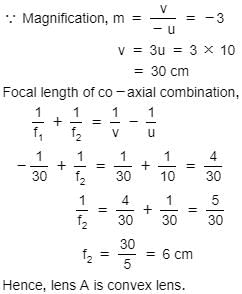
Find the angle of deviation (clockwise) suffered by a ray incident on a plane mirror, at an angle of incidence 30°. 
Correct answer is '240'. Can you explain this answer?
Find the angle of deviation (clockwise) suffered by a ray incident on a plane mirror, at an angle of incidence 30°.
|
|
Krishna Iyer answered |
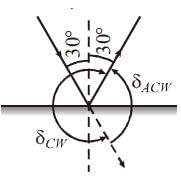
δ ACW = 180° – 60°
= 120° Anticlockwise
δ CW = 180° + 60°
= 240° Clockwise
In image formation from spherical mirrors, only paraxial rays are considered because they- a)are easy to handle geometrically
- b)contain most of the intensity of the incident light
- c)form nearly a point image of a point source
- d)show minimum dispersion effect.
Correct answer is option 'C'. Can you explain this answer?
In image formation from spherical mirrors, only paraxial rays are considered because they
a)
are easy to handle geometrically
b)
contain most of the intensity of the incident light
c)
form nearly a point image of a point source
d)
show minimum dispersion effect.
|
|
Riya Banerjee answered |
Paraxial rays are ones which originate from a point source and make a small angle with the principal axis. After reflection, they give a point image, either real or virtual.
But if rays from point source that are far from the mirror axis, gives a blurred image, an effect called spherical aberration.
But if rays from point source that are far from the mirror axis, gives a blurred image, an effect called spherical aberration.
If an object is placed unsymmetrically between two plane mirrors, inclined at the angle of 600, then the total number of images formed is- a)5
- b)4
- c)2
- d)infinite
Correct answer is option 'A'. Can you explain this answer?
If an object is placed unsymmetrically between two plane mirrors, inclined at the angle of 600, then the total number of images formed is
a)
5
b)
4
c)
2
d)
infinite
|
|
Hansa Sharma answered |
The number of images between two plane mirror inclined at an angle θ when the object is placed symmetrically between the mirrors is given as
n=(360o/ θ) −1
Given,
θ=60o
∴n=(360o/60)−1=6−1=5
n=(360o/ θ) −1
Given,
θ=60o
∴n=(360o/60)−1=6−1=5
Which of the following cannot form real image of a real object ?
- a)Concave mirror
- b)Convex mirror
- c)Plane mirror
- d)Diverging lens
Correct answer is option 'B'. Can you explain this answer?
Which of the following cannot form real image of a real object ?
a)
Concave mirror
b)
Convex mirror
c)
Plane mirror
d)
Diverging lens
|
|
Lavanya Menon answered |
A concave mirror can form both real and virtual images depending upon the distance between object and mirror.
A convex mirror can only form virtual, erect, and diminished images; therefore, it is true that it can never form a real image of a real object.
-Virtual image cannot be formed from a virtual object.
- When an object is placed between pole and focus, the image formed by the concave mirror is magnified, virtual and erect.
-When an object is placed beyond the centre of curvature , image of it is formed between centre of curvature and focus which is diminished,real and inverted,so real image of real object can be formed by concave mirror.
-When the object is virtual, the image formed is real for the concave surface as shown in figure.
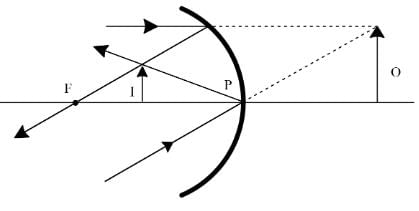
Two mirrors are placed perpendicular to each other. A ray strikes the first mirror and after reflection from the first mirror it falls on the second mirror. The ray after reflection from second mirror will emerge- a)Perpendicular to the original ray
- b)Parallel to the original ray
- c)At 450 to the original ray
- d)At 600 to the original ray
Correct answer is option 'B'. Can you explain this answer?
Two mirrors are placed perpendicular to each other. A ray strikes the first mirror and after reflection from the first mirror it falls on the second mirror. The ray after reflection from second mirror will emerge
a)
Perpendicular to the original ray
b)
Parallel to the original ray
c)
At 450 to the original ray
d)
At 600 to the original ray
|
|
Preeti Iyer answered |
Let ray strikes the vertical mirror by angle of incidence θ. Then by joining the perpendiculars of two mirrors it is clear from the diagram that angle of incidence at the horizontal mirror is (90−θ).
∴ reflected ray from the horizontal mirror makes angle θ with the horizontal mirror also incident ray at vertical mirror makes angle θ with horizontal axis.
∴ reflected ray is parallel to the original ray.
This is true for two perpendicular mirrors fixed at any positions.
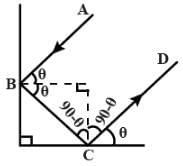
∴ reflected ray from the horizontal mirror makes angle θ with the horizontal mirror also incident ray at vertical mirror makes angle θ with horizontal axis.
∴ reflected ray is parallel to the original ray.
This is true for two perpendicular mirrors fixed at any positions.

Which of the following letters do not surface lateral inversion- a)HGA
- b)HOX
- c)VET
- d)YUL
Correct answer is option 'B'. Can you explain this answer?
Which of the following letters do not surface lateral inversion
a)
HGA
b)
HOX
c)
VET
d)
YUL
|
|
Hansa Sharma answered |
Lateral inversion-The phenomenon of left side appearing right side and right side appearing left side on reflection in a plane mirror is called lateral inversion.
Letters that do not show lateral inversion are,
A, H, I, M, O, T, U, V, W, X, Y
Hence, HOX will not show lateral inversion.
Letters that do not show lateral inversion are,
A, H, I, M, O, T, U, V, W, X, Y
Hence, HOX will not show lateral inversion.
A plano-convex lens, when silvered on the plane side, behaves like a concave mirror of focal length 30 cm. When it is silvered on the convex side, it behaves like a concave mirror of focal length 10 cm. The refractive index of the material of the lens is
- a)2.0
- b)2.5
- c)1.5
- d)3.0
Correct answer is option 'C'. Can you explain this answer?
A plano-convex lens, when silvered on the plane side, behaves like a concave mirror of focal length 30 cm. When it is silvered on the convex side, it behaves like a concave mirror of focal length 10 cm. The refractive index of the material of the lens is
a)
2.0
b)
2.5
c)
1.5
d)
3.0

|
Gauri Kaur answered |
3. 1.5
Solution: Let the radius of curvature of the convex surface of the plano-convex lens be RRR. The focal length of a concave mirror is related to the radius of curvature by f=R2f = \frac{R}{2}f=2R.
-
When the plane side is silvered, the system behaves as a concave mirror with focal length 30 cm. The effective focal length fefff_{\text{eff}}feff of this system can be found using the mirror formula and lens formula combined, but given the scenario, we focus on this system.
-
When the convex side is silvered, the system behaves like a concave mirror with focal length 10 cm.
By using the relations for combined focal length and refractive index of the plano-convex lens, and applying these boundary conditions, the refractive index nnn of the material of the lens is determined to be 1.5.
The objective of a telescope has a focal length of 1.2 m. It is used to view a 10.0 m tall tower 2 km away. What is the height of the image of the tower formed by the objective?- a)8 mm
- b)2 mm
- c)6 mm
- d)4 mm
Correct answer is option 'C'. Can you explain this answer?
The objective of a telescope has a focal length of 1.2 m. It is used to view a 10.0 m tall tower 2 km away. What is the height of the image of the tower formed by the objective?
a)
8 mm
b)
2 mm
c)
6 mm
d)
4 mm
|
|
Lavanya Menon answered |
α (Radian)=10/2000=1/200rad
α=h/F=h/1.2
h= α x 1.2
h=(1/200) x1.2 cm
=6mm
α=h/F=h/1.2
h= α x 1.2
h=(1/200) x1.2 cm
=6mm
The bluish color predominates in a clear sky,- a)Since blue has a is radiated much more strongly
- b)Since blue has a longer wavelength than red and is scattered much more strongly
- c)Since blue has a shorter wavelength than red and is scattered much more strongly
- d)Since blue has a shorter wavelength than red and is scattered much less strongly
Correct answer is option 'C'. Can you explain this answer?
The bluish color predominates in a clear sky,
a)
Since blue has a is radiated much more strongly
b)
Since blue has a longer wavelength than red and is scattered much more strongly
c)
Since blue has a shorter wavelength than red and is scattered much more strongly
d)
Since blue has a shorter wavelength than red and is scattered much less strongly
|
|
Suresh Kumar answered |
Sky is blue because of scattering of light of minimum wavelength i.e blue by the dust particles suspended in the air. so option c is correct
The focal length of spherical mirror is- a)Maximum for red light
- b)Maximum for blue light
- c)Maximum for white light
- d)Same for all lights
Correct answer is option 'D'. Can you explain this answer?
The focal length of spherical mirror is
a)
Maximum for red light
b)
Maximum for blue light
c)
Maximum for white light
d)
Same for all lights
|
|
Lavanya Menon answered |
Focal length is the property of a spherical mirror. It does not depend on the light used. So, it is the same for all lights.
Mark the correct options- a)If the incident rays are converging, we have a real object.
- b)If the final rays are converging, we have a real image.
- c)The image of a virtual object is called a virtual image.
- d)If the image is virtual, the corresponding object is called a virtual object
Correct answer is option 'B'. Can you explain this answer?
Mark the correct options
a)
If the incident rays are converging, we have a real object.
b)
If the final rays are converging, we have a real image.
c)
The image of a virtual object is called a virtual image.
d)
If the image is virtual, the corresponding object is called a virtual object
|
|
Geetika Shah answered |
If the final rays are converging, we have a real image.
This is because a real image is formed by converging reflected/refracted rays from a mirror/lens.
The correct answer is option B.
This is because a real image is formed by converging reflected/refracted rays from a mirror/lens.
The correct answer is option B.
Find the angle of deviation (anticlockwise) suffered by a ray incident on a plane mirror, at an angle of incidence 30°. 
Correct answer is '120'. Can you explain this answer?
Find the angle of deviation (anticlockwise) suffered by a ray incident on a plane mirror, at an angle of incidence 30°.
|
|
Lavanya Pamujula answered |
Angle of deviation is given by a formula : = π-2i. where π =180 degrees ,i=angle of incidence
A light ray is incident on a plane mirror, which after getting reflected strikes another plane mirror, as shown in figure. The angle between the two mirrors is 60°. Find the angle 'q' shown in figure. 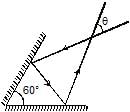
Correct answer is '60'. Can you explain this answer?
A light ray is incident on a plane mirror, which after getting reflected strikes another plane mirror, as shown in figure. The angle between the two mirrors is 60°. Find the angle 'q' shown in figure.

|
Sushil Kumar answered |
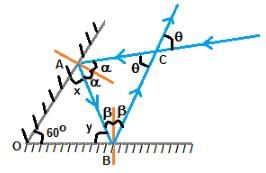
Figure shows two plane mirrors kept at angle 60°. A light ray incidents at A making an angle of incidence α,
reflected and again incidents at B making an angle β and getting reflected .
Reflected ray from B makes angle θ with the initial incident ray.
At reflection point A, as shown in figure, we have α+x = 90° ..............(1)
At reflection point B, as shown in figure, we have β+y = 90° ..............(2)
By adding (1) and (2), after substituting x+y = 120°, we get, α+β = 60° ...............(3)
From ΔABC, we have, 2α + 2β + θ = 180° ...................(4)
Hence By using eqn.(3), we get , θ = 180 - 120 = 60°
For a rectangular slab, refraction takes place at- a)Two interfaces
- b)Three interfaces
- c)Four interfaces
- d)One interfaces
Correct answer is option 'A'. Can you explain this answer?
For a rectangular slab, refraction takes place at
a)
Two interfaces
b)
Three interfaces
c)
Four interfaces
d)
One interfaces
|
|
Saanvi Bose answered |
Refraction in a Rectangular Slab
In a rectangular slab, refraction takes place at two interfaces.
Explanation:
- A rectangular slab can be considered as a prism with a rectangular cross-section.
- When a ray of light enters the slab from air (or any other medium), it undergoes refraction at the first interface between air and the slab.
- The angle of incidence and the angle of refraction are related by Snell's law: n1 sinθ1 = n2 sinθ2, where n1 and n2 are the refractive indices of air and the slab, respectively, and θ1 and θ2 are the angles of incidence and refraction, respectively.
- The refracted ray travels through the slab and undergoes refraction again when it exits the slab and enters air (or any other medium).
- The angle of incidence and the angle of refraction at the second interface are related by Snell's law in a similar manner.
- Therefore, refraction takes place at two interfaces in a rectangular slab.
Conclusion:
Refraction in a rectangular slab takes place at two interfaces, one when the ray enters the slab and another when it exits the slab.
In a rectangular slab, refraction takes place at two interfaces.
Explanation:
- A rectangular slab can be considered as a prism with a rectangular cross-section.
- When a ray of light enters the slab from air (or any other medium), it undergoes refraction at the first interface between air and the slab.
- The angle of incidence and the angle of refraction are related by Snell's law: n1 sinθ1 = n2 sinθ2, where n1 and n2 are the refractive indices of air and the slab, respectively, and θ1 and θ2 are the angles of incidence and refraction, respectively.
- The refracted ray travels through the slab and undergoes refraction again when it exits the slab and enters air (or any other medium).
- The angle of incidence and the angle of refraction at the second interface are related by Snell's law in a similar manner.
- Therefore, refraction takes place at two interfaces in a rectangular slab.
Conclusion:
Refraction in a rectangular slab takes place at two interfaces, one when the ray enters the slab and another when it exits the slab.
Which of the following statements accurately describes an image formed by a thin converging lens?- a)The image is always real and inverted within the focal length of the lens.
- b)The image is always larger than the object within the radius of curvature of the lens.
- c)The image is always smaller than the object outside the focal length of the lens.
- d)The image is always virtual and upright outside the radius of curvature of the lens.
Correct answer is option 'B'. Can you explain this answer?
Which of the following statements accurately describes an image formed by a thin converging lens?
a)
The image is always real and inverted within the focal length of the lens.
b)
The image is always larger than the object within the radius of curvature of the lens.
c)
The image is always smaller than the object outside the focal length of the lens.
d)
The image is always virtual and upright outside the radius of curvature of the lens.

|
Orion Classes answered |
- For a converging lens, the image is real, inverted, and reduced when the object is positioned at greater than twice the focal length or radius of curvature (O > 2F), real, inverted, and enlarged when the object is between the radius of curvature and the focal length (2F > O > F), and virtual, upright, and enlarged when the object is positioned within the focal length (O < F).
- The image is always real and inverted not within but outside the focal length of the lens.
- The image is always virtual and upright not outside the radius of curvature but within the focal point of the lens.
- The image is always smaller than the object outside not the focal length but the radius of curvature of the lens.
- Correctly stated, the image is always larger than the object within the radius of curvature of the lens.
An object is initially at a distance of 100 cm from a plane mirror. If the mirror approaches the object at a speed of 5 cm/s. Then after 6 s the distance between the object and its image will be- a)60 cm
- b)140 cm
- c)170 cm
- d)150 cm
Correct answer is option 'B'. Can you explain this answer?
An object is initially at a distance of 100 cm from a plane mirror. If the mirror approaches the object at a speed of 5 cm/s. Then after 6 s the distance between the object and its image will be
a)
60 cm
b)
140 cm
c)
170 cm
d)
150 cm
|
|
Lavanya Menon answered |
Given that,
The distance of object from plane mirror D=100cm
So, initial distance of image and object
=100−(−100)
=200cm
Now, object approaches the mirror with the speed=v=5cm/s
So, distance travelled by object in 6 sec
D=5×6
D=30cm
At this instant,
Distance between mirror and object
D=100−30
D=70cm
Now, the distance between image and object is
D=70−(−70)
D=140cm
Hence, the distance between the object and its image is 140 cm.
The distance of object from plane mirror D=100cm
So, initial distance of image and object
=100−(−100)
=200cm
Now, object approaches the mirror with the speed=v=5cm/s
So, distance travelled by object in 6 sec
D=5×6
D=30cm
At this instant,
Distance between mirror and object
D=100−30
D=70cm
Now, the distance between image and object is
D=70−(−70)
D=140cm
Hence, the distance between the object and its image is 140 cm.
The radius of curvature for a convex lens is 40 cm, for each surface. Its refractive index is 1.5. The focal length will be - a)40 cm
- b)20 cm
- c)80 cm
- d)30 cm
Correct answer is option 'A'. Can you explain this answer?
The radius of curvature for a convex lens is 40 cm, for each surface. Its refractive index is 1.5. The focal length will be
a)
40 cm
b)
20 cm
c)
80 cm
d)
30 cm
|
|
Hansa Sharma answered |
Let the radius of curvature of the convex lens are denoted as
For a convex lens
R1=+40cm [As it is towards right]
R2=-40cm [As it is towards left]
The refractive index of the lens [µ]=1.5
Let f is the focal length of the lens.
From lens maker's formula we know that –
1/f=[µ-1] [1/R1-1/R2]
1/f=[1.5-1][1/40-(1/-40)]
1/f=0.5 x (2/40)
1/f=1/40
f=40cm
Hence, the focal length of the lens is 40 cm.
For a convex lens
R1=+40cm [As it is towards right]
R2=-40cm [As it is towards left]
The refractive index of the lens [µ]=1.5
Let f is the focal length of the lens.
From lens maker's formula we know that –
1/f=[µ-1] [1/R1-1/R2]
1/f=[1.5-1][1/40-(1/-40)]
1/f=0.5 x (2/40)
1/f=1/40
f=40cm
Hence, the focal length of the lens is 40 cm.
Light rays from a point object- a)radiate in some lines
- b)radiate only to the side
- c)radiate in all directions
- d)radiate only at the front
Correct answer is option 'C'. Can you explain this answer?
Light rays from a point object
a)
radiate in some lines
b)
radiate only to the side
c)
radiate in all directions
d)
radiate only at the front

|
Ramesh Chand answered |
Light from each point on a luminous object travels outward in all directions in straight lines. Light travel at very high speeds, but is not instantaneously everywhere. Light from point object travels indefinitely until it collides with matter in its path to be partially absorbed and reflected.
A convex mirror has a focal length f. A real object, placed at a distance f in front of it from the pole, produces an image at- a)2 f
- b)f/2
- c)f
- d)¥
Correct answer is option 'B'. Can you explain this answer?
A convex mirror has a focal length f. A real object, placed at a distance f in front of it from the pole, produces an image at
a)
2 f
b)
f/2
c)
f
d)
¥
|
|
Preeti Iyer answered |
Here F=f
U=-f(-because it is present in front of a convex lens)
It is given that both focal length and object distance is f .
So according to lens formula 1/F=1/v+1/u
So 1/f=(1/v)+(-1/f)
=>1/f=(1/v)-(1/f)
So (1/f)+(1/f)=1/f
=>1+(1/f)=(1/v)
=>2/f=1/v
So from here we can say that v= f/2
Hence option B is correct.
U=-f(-because it is present in front of a convex lens)
It is given that both focal length and object distance is f .
So according to lens formula 1/F=1/v+1/u
So 1/f=(1/v)+(-1/f)
=>1/f=(1/v)-(1/f)
So (1/f)+(1/f)=1/f
=>1+(1/f)=(1/v)
=>2/f=1/v
So from here we can say that v= f/2
Hence option B is correct.
An observer looks at a tree of height 15 metre with a telescope of magnifying power 10. To him, the tree appears- a)15 times nearer
- b)10 times nearer
- c)15 times taller
- d)10 times taller
Correct answer is option 'B'. Can you explain this answer?
An observer looks at a tree of height 15 metre with a telescope of magnifying power 10. To him, the tree appears
a)
15 times nearer
b)
10 times nearer
c)
15 times taller
d)
10 times taller

|
Juhi Deshpande answered |
The angle subtended at the eye becomes 10 times larger.This happens only when the tree appears 10 times nearer.
The magnifying power of the telescope can be increased by- a)increasing the focal length of eyepiece
- b)fitting eye-piece of low power
- c)increasing the distance of an object
- d)fitting eye-piece of high power
Correct answer is option 'D'. Can you explain this answer?
The magnifying power of the telescope can be increased by
a)
increasing the focal length of eyepiece
b)
fitting eye-piece of low power
c)
increasing the distance of an object
d)
fitting eye-piece of high power
|
|
Bhaskar Ala answered |
Magnification directly proportional to the focal length..
A short pulse of white light is incident from air to a glass slab at normal incidence. After travelling through the slab, the first colour to emerge is- a) red
- b)blue
- c)green
- d)violet
Correct answer is option 'A'. Can you explain this answer?
A short pulse of white light is incident from air to a glass slab at normal incidence. After travelling through the slab, the first colour to emerge is
a)
red
b)
blue
c)
green
d)
violet
|
|
Gayatri Sharma answered |
Explanation:
When a short pulse of white light is incident from air to a glass slab at normal incidence, it enters the glass slab and undergoes refraction. The different colors of light have different wavelengths and hence, they bend at different angles. This phenomenon is called dispersion of light.
The refractive index of the glass is different for different colors of light. The refractive index for red light is the least and for violet light is the highest. Thus, the red light bends the least and violet light bends the most.
Emerging color:
As the white light enters the glass slab, it gets dispersed into its constituent colors. The red light has the least deviation and hence emerges first. The other colors follow in the order of their deviation, with violet light emerging last.
Thus, the first color to emerge from the glass slab is red.
Conclusion:
Hence, the correct option is (a) red.
When a short pulse of white light is incident from air to a glass slab at normal incidence, it enters the glass slab and undergoes refraction. The different colors of light have different wavelengths and hence, they bend at different angles. This phenomenon is called dispersion of light.
The refractive index of the glass is different for different colors of light. The refractive index for red light is the least and for violet light is the highest. Thus, the red light bends the least and violet light bends the most.
Emerging color:
As the white light enters the glass slab, it gets dispersed into its constituent colors. The red light has the least deviation and hence emerges first. The other colors follow in the order of their deviation, with violet light emerging last.
Thus, the first color to emerge from the glass slab is red.
Conclusion:
Hence, the correct option is (a) red.
An object is placed at a distance u from a concave mirror and its real image is received on a screen placed at a distance of v from the mirror. If f is the focal length of the mirror, then the graph between 1/v versus 1/u is- a)
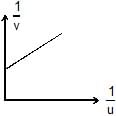
- b)
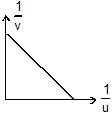
- c)

- d)
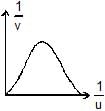
Correct answer is option 'B'. Can you explain this answer?
An object is placed at a distance u from a concave mirror and its real image is received on a screen placed at a distance of v from the mirror. If f is the focal length of the mirror, then the graph between 1/v versus 1/u is
a)
b)
c)
d)

|
Divey Sethi answered |
For real object and real Image,
(1/v)+(1/u)=(1/f)=> -(1/v)-(1/u)=-(1/f)
(1/v)+(1/u)=(1/f) => 1/v=-(1/u)+(1/f)
y=mx+c
The correct answer is option B.
(1/v)+(1/u)=(1/f)=> -(1/v)-(1/u)=-(1/f)
(1/v)+(1/u)=(1/f) => 1/v=-(1/u)+(1/f)
y=mx+c
The correct answer is option B.
A concave mirror gives an image three times as large as the object placed at a distance of 20 cm from it. For the image to be real, the focal length should be- a)10 cm
- b)15 cm
- c)20 cm
- d)30 cm
Correct answer is option 'B'. Can you explain this answer?
A concave mirror gives an image three times as large as the object placed at a distance of 20 cm from it. For the image to be real, the focal length should be
a)
10 cm
b)
15 cm
c)
20 cm
d)
30 cm
|
|
Hansa Sharma answered |
Given, u=−20cm
m=−3⇒−v/u =−3
v=−60cm
1/f=(1/v)+(1/u)=(-1/60)−(1/20)=−1−3/60
f=−60/4=−15cm
m=−3⇒−v/u =−3
v=−60cm
1/f=(1/v)+(1/u)=(-1/60)−(1/20)=−1−3/60
f=−60/4=−15cm
A concave mirror cannot form- a)virtual image of virtual object
- b)virtual image of a real object
- c)real image of a real object
- d)real image of a virutal object
Correct answer is option 'A'. Can you explain this answer?
A concave mirror cannot form
a)
virtual image of virtual object
b)
virtual image of a real object
c)
real image of a real object
d)
real image of a virutal object
|
|
Ritu Singh answered |
-Virtual image cannot be formed from a virtual object.
- When an object is placed between pole and focus, the image formed by the concave mirror is magnified, virtual and erect.
-When an object is placed beyond the centre of curvature , the image of it is formed between the centre of curvature and focus which is diminished,real and inverted,so the real image of the real object can be formed by a concave mirror.
-When the object is virtual, the image formed is real for the concave surface as shown in figure.
- When an object is placed between pole and focus, the image formed by the concave mirror is magnified, virtual and erect.
-When an object is placed beyond the centre of curvature , the image of it is formed between the centre of curvature and focus which is diminished,real and inverted,so the real image of the real object can be formed by a concave mirror.
-When the object is virtual, the image formed is real for the concave surface as shown in figure.
A convex lens forms a real image of an object on a screen; the magnification of the image being 3/2. The object and the screen are kept fixed and the lens is moved through a distance of 16 cm when a sharp image is again formed on the screen; the magnification now being 2/3. What is the focal length of the lens?- a)19.6 cm
- b)19.2 cm
- c)20 cm
- d)20.4 cm
Correct answer is option 'B'. Can you explain this answer?
A convex lens forms a real image of an object on a screen; the magnification of the image being 3/2. The object and the screen are kept fixed and the lens is moved through a distance of 16 cm when a sharp image is again formed on the screen; the magnification now being 2/3. What is the focal length of the lens?
a)
19.6 cm
b)
19.2 cm
c)
20 cm
d)
20.4 cm
|
|
Gaurav Kumar answered |
3/2=v/u…...1
2/3=(v-16)/(u+16)......2
from these equation
we get v=48, u=32
so now f=(vxu)/(v+u)=96/5=19.2
The correct answer is option B.
2/3=(v-16)/(u+16)......2
from these equation
we get v=48, u=32
so now f=(vxu)/(v+u)=96/5=19.2
The correct answer is option B.
Statement-I : When an object dipped in a liquid is viewed normally, the distance between the image and the object is indepedent of the height of the liquid above the object.Statement-II : The normal shift is independent of the location of the slab between the object and the observer.- a)Statement-1 is true, statement-2 is true; statement-2 is correct explanantion for satement-1
- b)Statement-1 is true, statement-2 is true; statement-2 is NOT correct explanantion for satement-1
- c)Statement-1 is true, Statement-2 is false.
- d)Statement-1 is false, statement-2 is true.
Correct answer is option 'D'. Can you explain this answer?
Statement-I : When an object dipped in a liquid is viewed normally, the distance between the image and the object is indepedent of the height of the liquid above the object.
Statement-II : The normal shift is independent of the location of the slab between the object and the observer.
a)
Statement-1 is true, statement-2 is true; statement-2 is correct explanantion for satement-1
b)
Statement-1 is true, statement-2 is true; statement-2 is NOT correct explanantion for satement-1
c)
Statement-1 is true, Statement-2 is false.
d)
Statement-1 is false, statement-2 is true.
|
|
Deepak Kapoor answered |
a) At first the height of the liquid level is obviously dependent because the normal shift will happen according to the depth of the liquid.
Drawing a ray diagram keeping a coin at very deep and another close to the surface.We will notice that the earlier one will have a noticeable change of position but the later one will only change a bit.
b) The position of the slab is independent because wherever we keep it the incident ray & the emergent ray at last will be parallel (same medium keeping in mind).
Drawing a ray diagram keeping a coin at very deep and another close to the surface.We will notice that the earlier one will have a noticeable change of position but the later one will only change a bit.
b) The position of the slab is independent because wherever we keep it the incident ray & the emergent ray at last will be parallel (same medium keeping in mind).
If an object is 30 cm away from a concave mirror of focal length 15 cm, the image will be- a)erect
- b)virtual
- c)diminished
- d)of same size
Correct answer is option 'D'. Can you explain this answer?
If an object is 30 cm away from a concave mirror of focal length 15 cm, the image will be
a)
erect
b)
virtual
c)
diminished
d)
of same size
|
|
Nandita Ahuja answered |
Explanation:
When an object is placed at a distance of 2f (twice the focal length) from a concave mirror, the image formed is of the same size as the object.
In this case, the object is placed at a distance of 30 cm from a concave mirror of focal length 15 cm. So, the distance between the object and the mirror is:
u = -30 cm (since the object is placed in front of the mirror)
f = -15 cm (since the mirror is concave)
Using the mirror formula:
1/f = 1/v + 1/u
1/-15 = 1/v + 1/-30
-2/30 = 1/v
v = -15 cm
So, the image is formed at a distance of 15 cm from the mirror. The magnification is given by:
m = -v/u
m = -15/-30
m = 1/2
Since the magnification is positive, the image formed is erect. And since the magnification is less than 1, the image formed is diminished.
However, since the object is placed at a distance of 2f from the mirror, the image formed is of the same size as the object. Therefore, option D is the correct answer.
When an object is placed at a distance of 2f (twice the focal length) from a concave mirror, the image formed is of the same size as the object.
In this case, the object is placed at a distance of 30 cm from a concave mirror of focal length 15 cm. So, the distance between the object and the mirror is:
u = -30 cm (since the object is placed in front of the mirror)
f = -15 cm (since the mirror is concave)
Using the mirror formula:
1/f = 1/v + 1/u
1/-15 = 1/v + 1/-30
-2/30 = 1/v
v = -15 cm
So, the image is formed at a distance of 15 cm from the mirror. The magnification is given by:
m = -v/u
m = -15/-30
m = 1/2
Since the magnification is positive, the image formed is erect. And since the magnification is less than 1, the image formed is diminished.
However, since the object is placed at a distance of 2f from the mirror, the image formed is of the same size as the object. Therefore, option D is the correct answer.
A person is in a room whose ceiling and two adjacent walls are mirrors. How many images are formed ?- a)5
- b)6
- c)7
- d)8
Correct answer is option 'C'. Can you explain this answer?
A person is in a room whose ceiling and two adjacent walls are mirrors. How many images are formed ?
a)
5
b)
6
c)
7
d)
8
|
|
Geetika Shah answered |
The number of images formed when two mirrors are inclined to each other is given by :
n=(360/θ -1)
here θ= 90°[since walls are perpendicular]
so, number of images=n=360/90-1
=4-1
=3
These 3 images are formed by a combination of two adjacent walls with the object itself acts as objects for the ceiling mirror. So totally 4 images are formed.
Hence total number of images formed are 4+3= 7
n=(360/θ -1)
here θ= 90°[since walls are perpendicular]
so, number of images=n=360/90-1
=4-1
=3
These 3 images are formed by a combination of two adjacent walls with the object itself acts as objects for the ceiling mirror. So totally 4 images are formed.
Hence total number of images formed are 4+3= 7
A unnumbered wall clock shows time 04 : 25 : 37, where 1st term represents hours, 2nd represents minutes & the last term represents seconds, What time will its image in a plane mirror show.- a)08 : 35 : 23
- b)07 : 35 : 23
- c) 07 : 34 : 23
- d) None of these
Correct answer is option 'C'. Can you explain this answer?
A unnumbered wall clock shows time 04 : 25 : 37, where 1st term represents hours, 2nd represents minutes & the last term represents seconds, What time will its image in a plane mirror show.
a)
08 : 35 : 23
b)
07 : 35 : 23
c)
07 : 34 : 23
d)
None of these
|
|
Anjana Sharma answered |
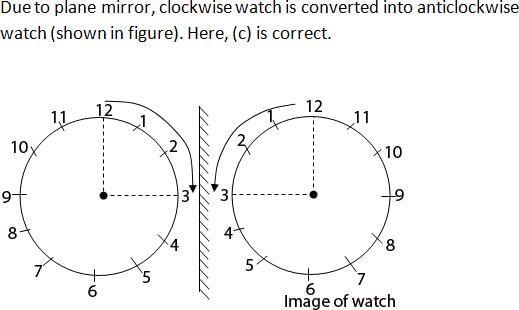
A transparent sphere of radius R and refractive index m. An object O is placed at a distance x from the pole of the first surface so that a real image is formed at the pole of the exactly opposite surface.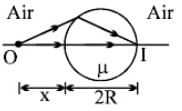 If x = 2R, then the value of m is
If x = 2R, then the value of m is- a)1.5
- b)2
- c)3
- d)None
Correct answer is option 'C'. Can you explain this answer?
A transparent sphere of radius R and refractive index m. An object O is placed at a distance x from the pole of the first surface so that a real image is formed at the pole of the exactly opposite surface.

If x = 2R, then the value of m is
a)
1.5
b)
2
c)
3
d)
None

|
EduRev Support answered |
(μ/v)- (μ/u) = (μ2- μ1)/R
Or, (μ/2R) + (1/2R) = μ-1/R
Or, (μ/2) + (1/2) = (μ-1)/1
Or, (Μ+1)/2= μ-1
Or, μ+1=2μ-2
μ=3
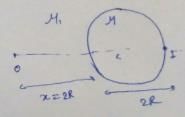
Or, (μ/2R) + (1/2R) = μ-1/R
Or, (μ/2) + (1/2) = (μ-1)/1
Or, (Μ+1)/2= μ-1
Or, μ+1=2μ-2
μ=3

Find focal length of mirror that forms an image 6.2 cm behind mirror of an object placed at 26 cm in front of mirror?- a)−6.58 cm
- b)−8.41 cm
- c)−7.8 cm
- d)−9.6 cm
Correct answer is option 'B'. Can you explain this answer?
Find focal length of mirror that forms an image 6.2 cm behind mirror of an object placed at 26 cm in front of mirror?
a)
−6.58 cm
b)
−8.41 cm
c)
−7.8 cm
d)
−9.6 cm
|
|
Lavanya Menon answered |
Here, given that,
v=-6.2 and u=26
we have to find,f=?
So, we know,
1/f=(1/u)+(1/v)
1/f=(1/-6.2) + (1/26)
f=-8.41cm
Hence the correct answer is option B.
v=-6.2 and u=26
we have to find,f=?
So, we know,
1/f=(1/u)+(1/v)
1/f=(1/-6.2) + (1/26)
f=-8.41cm
Hence the correct answer is option B.
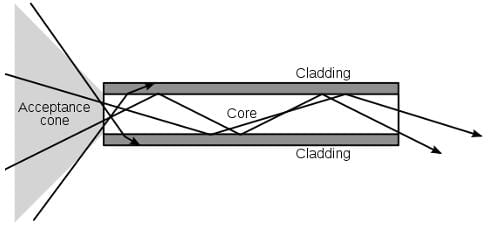 Above is a schematic of a fiber optic cable, which maintains total internal reflection throughout the length of the cable. The index of refraction of the cladding of a cable is generally 1.52, while the core has an index of refraction of 1.62 Choosing from the list below, what is the smallest angle of incidence light could have to enter from the acceptance cone that would be able to ‘escape’ the fiber optic cable?
Above is a schematic of a fiber optic cable, which maintains total internal reflection throughout the length of the cable. The index of refraction of the cladding of a cable is generally 1.52, while the core has an index of refraction of 1.62 Choosing from the list below, what is the smallest angle of incidence light could have to enter from the acceptance cone that would be able to ‘escape’ the fiber optic cable?- a)60°
- b)30°
- c)45°
- d)80°
Correct answer is option 'B'. Can you explain this answer?

Above is a schematic of a fiber optic cable, which maintains total internal reflection throughout the length of the cable. The index of refraction of the cladding of a cable is generally 1.52, while the core has an index of refraction of 1.62 Choosing from the list below, what is the smallest angle of incidence light could have to enter from the acceptance cone that would be able to ‘escape’ the fiber optic cable?
a)
60°
b)
30°
c)
45°
d)
80°

|
Orion Classes answered |
- There are multiple ways to come to an answer. You can use the critical angle formula sin θc = n2/n1 but this requires some math gymnastics.
- One important realization to make is that the larger an angle of incidence is, the more likely it will be internally reflected. The angle of incidence is measured between the ray of light and the normal of the inside of the cable, therefore in the figure, the rays coming in from outside the acceptance cone would have the lowest angle of incidence.
- Since we’re looking for the smallest angle of incidence possible to escape the cable, we should simply pick 30°
- The harder way, if we use the formula, would give the result of sin θc = 1.52/1.62. We probably would need a calculator to solve this directly, but we should know the sine of 30°, 45°, and 60° , which are the available answer choices. Additionally, we know we want to find the smallest angle, so we can focus on 30°
- sin (30°) = 1/2, therefore sin (30°) is much smaller than the sin (θc), which is all we need to know. Remember, if an angle is smaller than the critical angle, it will not be internally reflected! Since 30° is our smallest incident angle choice, even if the other angles can ‘escape’ the cable, 30° must be the correct answer.
One of the challenges of using an astronomical telescope for terrestrial use is the production of an inverted image. Which of the following changes to the astronomical telescope would invert the image for terrestrial use?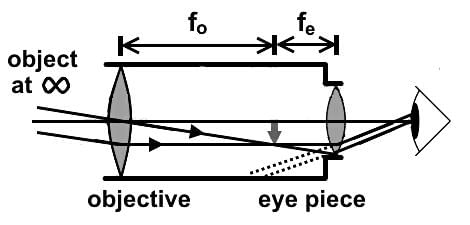
- a)Move the eyepiece to within the focal point of the objective such that their focal lengths overlap
- b)Change the eyepiece to a diverging lens leaving the lens in the same position
- c)Add a third converging lens in between such that the image from the objective falls 2 focal lengths from the lens
- d)Change the objective to a diverging lens and leave it is the same position
Correct answer is option 'C'. Can you explain this answer?
One of the challenges of using an astronomical telescope for terrestrial use is the production of an inverted image. Which of the following changes to the astronomical telescope would invert the image for terrestrial use?

a)
Move the eyepiece to within the focal point of the objective such that their focal lengths overlap
b)
Change the eyepiece to a diverging lens leaving the lens in the same position
c)
Add a third converging lens in between such that the image from the objective falls 2 focal lengths from the lens
d)
Change the objective to a diverging lens and leave it is the same position
|
|
Ayesha Joshi answered |
- Changing the objective to a diverging lens would not properly gather light into the telescope in producing a virtual image outside the telescope. Only a converging lens would work for the first lens.
- Changing the eyepiece to a converging lens would not invert the image vertically but laterally. The virtual image would be projected back into the telescope rather than on the retina.
- Moving the eyepiece to within the focal point of the objective such that they overlap would require the additional step of changing the eyepiece to a diverging lens to create the virtual, upright, and enlarged image:

- Adding a third converging lens in between such that the image from the objective falls 2 focal lengths from the lens would properly invert the image:
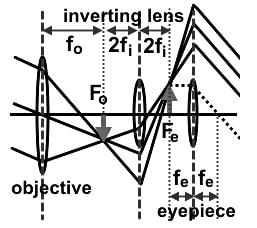
Which of the following statements best describes the schematic of the astronomical telescope below?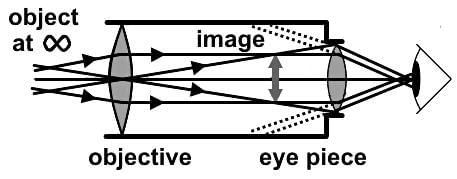
- a)Magnification can be increased by shortening the focal length of the objective.
- b)The telescope makes use of two positive lens, and each lens inverts the image such that the final image is upright.
- c)The eyepiece acts like a simple magnifier for the image produced by the objective by producing a virtual, inverted, and enlarged image at infinity.
- d)If the focal length of objective is 50 cm and the eyepiece is -10 cm, then the telescope should be at least 60 cm in length.
Correct answer is option 'C'. Can you explain this answer?
Which of the following statements best describes the schematic of the astronomical telescope below?

a)
Magnification can be increased by shortening the focal length of the objective.
b)
The telescope makes use of two positive lens, and each lens inverts the image such that the final image is upright.
c)
The eyepiece acts like a simple magnifier for the image produced by the objective by producing a virtual, inverted, and enlarged image at infinity.
d)
If the focal length of objective is 50 cm and the eyepiece is -10 cm, then the telescope should be at least 60 cm in length.

|
Orion Classes answered |
- The telescope is equal to the sum of the focal lengths of the objective and eyepiece. The focal length should have positive values they are both converging.
- Since the objective lens is responsible for gathering light.
- The telescope makes use of two converging lenses. The objective produces a real and inverted image. If you follow the light rays, they switch sides when refracting through the lens.
- The eyepiece acts like a simple magnifier to enlarge the image formed by the objective. That image should fall on or within the focal point of the eyepiece.
- Since the image from the objective is already inverted, the image produced by the eyepiece will be virtual, enlarged, and inverted.
Two lenses that are 30 centimeters apart are used to form an image. Lens 1 has a focal length f1 = -5.0 cm, and lens 2 has a focal length f2 = 15 cm. The object is placed 20 centimeters to the left of Lens 1. Which of the following statements best describes the image formed?- a)The image formed by Lens 2 is real, inverted, and reduced.
- b)The image formed by Lens 2 is real, upright, and enlarged.
- c)The image formed by Lens 1 is virtual, inverted, and reduced.
- d)The image formed by Lens 1 is virtual, upright, and enlarged.
Correct answer is option 'A'. Can you explain this answer?
Two lenses that are 30 centimeters apart are used to form an image. Lens 1 has a focal length f1 = -5.0 cm, and lens 2 has a focal length f2 = 15 cm. The object is placed 20 centimeters to the left of Lens 1. Which of the following statements best describes the image formed?
a)
The image formed by Lens 2 is real, inverted, and reduced.
b)
The image formed by Lens 2 is real, upright, and enlarged.
c)
The image formed by Lens 1 is virtual, inverted, and reduced.
d)
The image formed by Lens 1 is virtual, upright, and enlarged.
|
|
Ayesha Joshi answered |
- This problem can be solved with some ray diagrams with some deduction or with the thin lens equation performed twice.
- The first lens is diverging lens since the focal length is negative, and the second lens is converging since the focal length is positive.
- The object is placed well outside the focal length for the diverging lens, but regardless of position, the image produced is virtual, upright, and reduced. The further away from the focal length, the smaller the image.
- This virtual image is the object for the converging lens, which falls well outside the radius of curvature or twice the focal length. In this case, the second lens will produce a real, inverted, and reduced image.
Which of the following statements accurately describes the sign conventions used for the thin lens equation?- a)The focal length of a lens whose refractive power is positive is negative.
- b)While the magnitude of the magnification indicates whether an image is enlarged or reduced, the signage indicates whether it is inverted or upright.
- c)Distances to the right of the lens are negative and on the left are positive.
- d)The distance of a virtual image is positive since it appears on the same side of the lens.
Correct answer is option 'B'. Can you explain this answer?
Which of the following statements accurately describes the sign conventions used for the thin lens equation?
a)
The focal length of a lens whose refractive power is positive is negative.
b)
While the magnitude of the magnification indicates whether an image is enlarged or reduced, the signage indicates whether it is inverted or upright.
c)
Distances to the right of the lens are negative and on the left are positive.
d)
The distance of a virtual image is positive since it appears on the same side of the lens.
|
|
Owen Jenkins answered |
Explanation:
Magnification and Image Orientation:
- The sign conventions used in the thin lens equation indicate the orientation of the image formed by a lens.
- While the magnitude of the magnification tells us whether the image is enlarged or reduced, the signage (positive or negative) indicates whether the image is upright or inverted.
Positive and Negative Signs for Distances:
- In the thin lens equation, distances are measured from the lens to the object or image.
- Distances to the left of the lens are typically taken as positive, while distances to the right of the lens are considered negative.
Virtual Images and Sign Conventions:
- When an image is virtual (formed on the same side as the object), the distance is considered positive.
- Virtual images have a negative magnification value, indicating that they are upright.
Therefore, statement B accurately describes the sign conventions used for the thin lens equation as it highlights the significance of both magnitude and signage in determining the orientation of the image formed by a lens.
Magnification and Image Orientation:
- The sign conventions used in the thin lens equation indicate the orientation of the image formed by a lens.
- While the magnitude of the magnification tells us whether the image is enlarged or reduced, the signage (positive or negative) indicates whether the image is upright or inverted.
Positive and Negative Signs for Distances:
- In the thin lens equation, distances are measured from the lens to the object or image.
- Distances to the left of the lens are typically taken as positive, while distances to the right of the lens are considered negative.
Virtual Images and Sign Conventions:
- When an image is virtual (formed on the same side as the object), the distance is considered positive.
- Virtual images have a negative magnification value, indicating that they are upright.
Therefore, statement B accurately describes the sign conventions used for the thin lens equation as it highlights the significance of both magnitude and signage in determining the orientation of the image formed by a lens.
A point object is kept in front of a plane mirror. The plane mirror is doing SHM of amplitude 2cm. The plane mirror moves along the x-axis and x-axis is normal to the mirror. The amplitude of the mirror is such that the object is always infront of the mirror. The amplitude of SHM of the image is- a)zero
- b)2 cm
- c)4 cm
- d)1 cm
Correct answer is option 'C'. Can you explain this answer?
A point object is kept in front of a plane mirror. The plane mirror is doing SHM of amplitude 2cm. The plane mirror moves along the x-axis and x-axis is normal to the mirror. The amplitude of the mirror is such that the object is always infront of the mirror. The amplitude of SHM of the image is
a)
zero
b)
2 cm
c)
4 cm
d)
1 cm
|
|
Jayant Mishra answered |
The answer is 4cm.
In reflection on a plane mirror the image distance is equal to the object distance.
The size of the image equals to the size of the object.
Therefore the size of the amplitude of the reflected amplitude equals the size of the original amplitude.
A rays is incident at an angle 38º on a mirror. The angle between normal and reflected ray is- a)38º
- b)52º
- c)90º
- d)76º
Correct answer is option 'A'. Can you explain this answer?
A rays is incident at an angle 38º on a mirror. The angle between normal and reflected ray is
a)
38º
b)
52º
c)
90º
d)
76º
|
|
Kalyan Joshi answered |
As per the question, rays are falling on the mirror, which cleared that Regular reflection is taking place.
So, As per the laws of regular reflection.
=> ∠incident= ∠reflection
∠incident= ∠reflection=38Ao
Also we know that normal is at 90°to the mirror.
Now, to get the required angle we need to reduce angle of reflection from normal.
=>90Ao-38Ao=52Ao
so, the correct answer is option B.
So, As per the laws of regular reflection.
=> ∠incident= ∠reflection
∠incident= ∠reflection=38Ao
Also we know that normal is at 90°to the mirror.
Now, to get the required angle we need to reduce angle of reflection from normal.
=>90Ao-38Ao=52Ao
so, the correct answer is option B.
A person is standing in a room of width 200 cm. A plane mirror of vertical length 10 cm is fixed on a wall in front of the person. The person looks into the mirror from distance 50 cm. How much width (height) of the wall behind him will he be able to see : (assume that he uses the full mirror)- a)30 cm
- b)40 cm
- c)50 cm
- d) None
Correct answer is option 'C'. Can you explain this answer?
A person is standing in a room of width 200 cm. A plane mirror of vertical length 10 cm is fixed on a wall in front of the person. The person looks into the mirror from distance 50 cm. How much width (height) of the wall behind him will he be able to see : (assume that he uses the full mirror)
a)
30 cm
b)
40 cm
c)
50 cm
d)
None
|
|
Arka Das answered |
Given data:
Width of the room = 200 cm
Vertical length of the plane mirror = 10 cm
Distance of the person from the mirror = 50 cm
To find:
The width (height) of the wall behind him that he will be able to see.
Solution:
Let AB be the plane mirror fixed on the wall.
Let C be the person standing in front of the mirror.
Draw the perpendicular CD from C to AB.
Let the width of the wall behind the person be EF.
So, we need to find the value of EF.
We know that the angle of incidence is equal to the angle of reflection.
So, the image of the person in the mirror is formed at E.
Join CE.
Now, we have two right triangles ACD and BCE.
Using the concept of similar triangles, we can write:
AC/BC = CD/CE
AC + BC = 50 cm (Given)
AC/BC = CD/CE = 1/10 (Vertical length of the mirror is 10 cm)
On solving, we get:
AC = 5 cm and BC = 45 cm
Using Pythagoras theorem in triangle BCE, we get:
BE^2 + CE^2 = BC^2
BE^2 + (CD + DE)^2 = 45^2
BE^2 + (5 + DE)^2 = 2025
Using Pythagoras theorem in triangle CDE, we get:
DE^2 + CD^2 = CE^2
DE^2 + 50^2 = CE^2
Adding both equations, we get:
BE^2 + DE^2 + (5 + DE)^2 + 50^2 = 2025 + 2025
BE^2 + DE^2 + 10DE + 2525 = 4050
BE^2 + DE^2 + 10DE - 1525 = 0
Now, we know that the image of the person is formed at point E.
So, the width of the wall behind him that he will be able to see is equal to the distance between the points E and F.
Let the distance between E and F be x cm.
Using Pythagoras theorem in triangle DEF, we get:
DE^2 + EF^2 = DF^2
DE^2 + x^2 = (BE + BC)^2
DE^2 + x^2 = 50^2
x^2 = 2500 - DE^2
Substituting the value of DE^2 from the previous equation, we get:
x^2 = 2500 - BE^2 - DE^2 - 10DE
x^2 = 2500 - BE^2 - DE^2 - 10DE + 1525
x^2 = 4025 - BE^2 - DE^2 - 10DE
x^2 = 4025 - 2025
x^2 = 2000
x = √2000
x = 20√5
Therefore, the width (height) of the wall behind him that he will be able to see is 20√5 cm, which is approximately 44.7 cm (rounded to one decimal place).
Hence, the correct option is (c) 50 cm.
Width of the room = 200 cm
Vertical length of the plane mirror = 10 cm
Distance of the person from the mirror = 50 cm
To find:
The width (height) of the wall behind him that he will be able to see.
Solution:
Let AB be the plane mirror fixed on the wall.
Let C be the person standing in front of the mirror.
Draw the perpendicular CD from C to AB.
Let the width of the wall behind the person be EF.
So, we need to find the value of EF.
We know that the angle of incidence is equal to the angle of reflection.
So, the image of the person in the mirror is formed at E.
Join CE.
Now, we have two right triangles ACD and BCE.
Using the concept of similar triangles, we can write:
AC/BC = CD/CE
AC + BC = 50 cm (Given)
AC/BC = CD/CE = 1/10 (Vertical length of the mirror is 10 cm)
On solving, we get:
AC = 5 cm and BC = 45 cm
Using Pythagoras theorem in triangle BCE, we get:
BE^2 + CE^2 = BC^2
BE^2 + (CD + DE)^2 = 45^2
BE^2 + (5 + DE)^2 = 2025
Using Pythagoras theorem in triangle CDE, we get:
DE^2 + CD^2 = CE^2
DE^2 + 50^2 = CE^2
Adding both equations, we get:
BE^2 + DE^2 + (5 + DE)^2 + 50^2 = 2025 + 2025
BE^2 + DE^2 + 10DE + 2525 = 4050
BE^2 + DE^2 + 10DE - 1525 = 0
Now, we know that the image of the person is formed at point E.
So, the width of the wall behind him that he will be able to see is equal to the distance between the points E and F.
Let the distance between E and F be x cm.
Using Pythagoras theorem in triangle DEF, we get:
DE^2 + EF^2 = DF^2
DE^2 + x^2 = (BE + BC)^2
DE^2 + x^2 = 50^2
x^2 = 2500 - DE^2
Substituting the value of DE^2 from the previous equation, we get:
x^2 = 2500 - BE^2 - DE^2 - 10DE
x^2 = 2500 - BE^2 - DE^2 - 10DE + 1525
x^2 = 4025 - BE^2 - DE^2 - 10DE
x^2 = 4025 - 2025
x^2 = 2000
x = √2000
x = 20√5
Therefore, the width (height) of the wall behind him that he will be able to see is 20√5 cm, which is approximately 44.7 cm (rounded to one decimal place).
Hence, the correct option is (c) 50 cm.
Chapter doubts & questions for Geometrical Optics (PHY) - MCAT Chemical and Physical Foundations 2025 is part of MCAT exam preparation. The chapters have been prepared according to the MCAT exam syllabus. The Chapter doubts & questions, notes, tests & MCQs are made for MCAT 2025 Exam. Find important definitions, questions, notes, meanings, examples, exercises, MCQs and online tests here.
Chapter doubts & questions of Geometrical Optics (PHY) - MCAT Chemical and Physical Foundations in English & Hindi are available as part of MCAT exam.
Download more important topics, notes, lectures and mock test series for MCAT Exam by signing up for free.
MCAT Chemical and Physical Foundations
336 videos|223 docs|109 tests
|

Contact Support
Our team is online on weekdays between 10 AM - 7 PM
Typical reply within 3 hours
|
Free Exam Preparation
at your Fingertips!
Access Free Study Material - Test Series, Structured Courses, Free Videos & Study Notes and Prepare for Your Exam With Ease

 Join the 10M+ students on EduRev
Join the 10M+ students on EduRev
|

|
Create your account for free
OR
Forgot Password
OR
Signup on EduRev and stay on top of your study goals
10M+ students crushing their study goals daily

